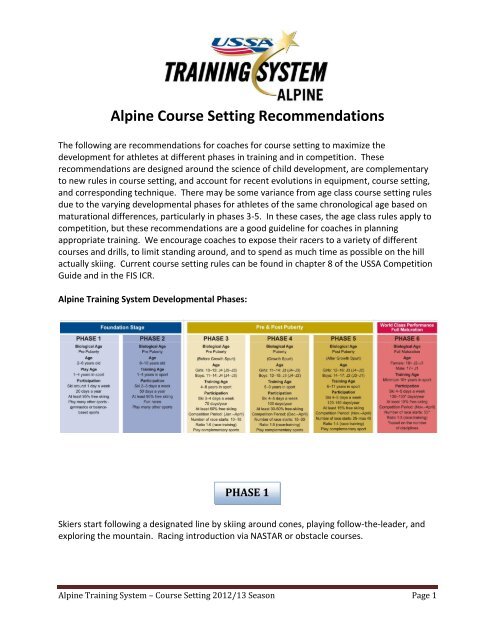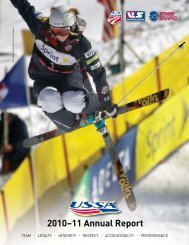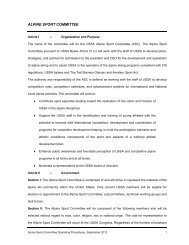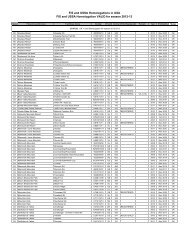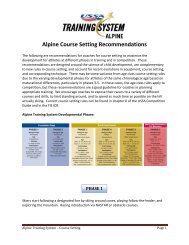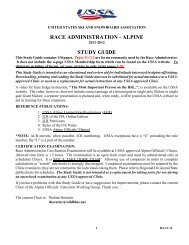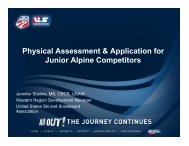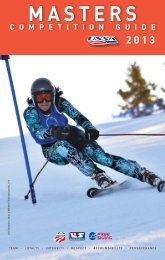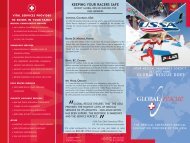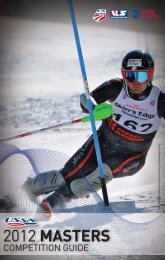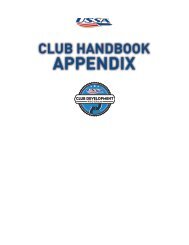Alpine Course Setting Recommendations - US Ski Team - Alpine
Alpine Course Setting Recommendations - US Ski Team - Alpine
Alpine Course Setting Recommendations - US Ski Team - Alpine
Create successful ePaper yourself
Turn your PDF publications into a flip-book with our unique Google optimized e-Paper software.
SLALOM:TrainingProgress from brushes to stubbies. Use of junior flex poles (shorter shaft, 25-27mmdiameter, light-weight hinge). Gate clearing habits learned here will stay with theseskiers for some time. Coaches must demand proper clearing and using age-appropriategates can help phase 3 skiers clear correctly (think of the smaller ball for youth soccer orlower hoop for youth basketball). Set a stubbie or brush course alongside the juniorgate course so that coaches can move skiers back and forth depending on their ability tomaintain proper body position.Typical characteristics –recommended distance between gates in combinations 4-5.5m,recommended distance between open gates 6-10mo Always set outside gate of hairpin/flush and delay gate in trainingRather than setting one 30-40 gate training course, split the hill in 2 or 3 shorter courses(10-15 gates) and emphasize focus for each section on a specific technical tasko Set a start and finish gate for each section so athletes always practice a strongstart and skiing through the finishCompetitionMaximum distance between turning gates: 9-10mNormal distance between turning gates: 7-9mNormal distance between poles in combinations: 4-5.5mChanges in rhythm requiring different turn shapes, but not tactically challenging<strong>Course</strong> length: recommend 25-35 direction changesDual format is encouraged for race efficiency (independent timing systems)GIANT SLALOM:TrainingUse brushes, stubbies, and paneled gatesRecommend distances of 17-24m between gatesAlways set outside gate of delay gate in trainingMaximize variety, in a progressive manner (start easy and increase challenge usingslope, offset, vertical distances, rhythm variability)Rather than setting one 20-30 gate training course, split the hill in 2 or 3 shorter courses(around 10 gates) and emphasize focus for each section on a specific technical tasko Set a start and finish gate for each section so athletes always practice a strongstart and skiing through the finishCompetitionMaximum distance between turning gates: 22-24mNormal distance between turning gates: 18-22mChanges in rhythm requiring different turn shapes, but not tactically challenging<strong>Course</strong> length: recommend 15-25 direction changesDual format is encouraged for race efficiency (independent timing systems)<strong>Alpine</strong> Training System – <strong>Course</strong> <strong>Setting</strong> 2012/13 Season Page 4
KOMBI:TrainingUse brushes, stubbies, and paneled gatesUse both GS/SL Kombi and GS/SG KombiFor GS/SL Kombi, recommended distances between gates for SL sections: 6-10m, for GSsections: 12-20mFor GS/SG Kombi, recommended distances between gates for GS sections: 12-20m, forSG sections: 18-28mFor GS/SL Kombi, course changes back and forth between SL and GS, GS sectionstypically 3-5 gates and SL sections 4-6 gatesFor GS/SG Kombi, course changes back and forth between GS and SG, sections typically3-6 gates between transitions<strong>Course</strong> should use the entire slope, working across the fall line as often as possible<strong>Course</strong> should be set such that a smooth transition between sections is possible<strong>Course</strong> should include at least one jumpCompetitionSame as for trainingGS/SL Kombi contains 5-6 different sections with around 30-35 turnsGS/SG Kombi contains 3-5 different sections with around 20 turnsSUPER G:TrainingEmphasis is on elements training – jumping and gliding skills<strong>Course</strong> setting should be appropriate for skiers on GS skisRecommended distances between turns range from 22-35mCompetitionSet on moderate terrainDistance between turns from 22-35m, use full spectrum, but make sure coursemaintains rhythm and flowSets are generally basic and control the skier's speed, no abrupt turns or terrain atspeedJumps, if included, should go with flow of course and direction of turns, skier shouldeasily be able to attain a balanced position at the lip of the jump. Jumps haveappropriate landings, and are generally on the upper part of the course.PHASE 4Background:Phase 4 skiers generally are in U14 or U16 age groups. <strong>Ski</strong>ers in this phase are into their growthspurt. For many skiers, the challenge will be to maintain their technical skills through thisphase. Gate training becomes a greater percentage of training time. <strong>Course</strong> setting shouldbegin to challenge the skiers' tactics to a greater degree through more substantial rhythm<strong>Alpine</strong> Training System – <strong>Course</strong> <strong>Setting</strong> 2012/13 Season Page 5
SUPER G:TrainingEmphasis is on elements training – jumping and gliding skillsRecommended distances between turns range from 25-45mCompetitionSet on moderate terrainDistance between turns from 25-40m, use full spectrum, but make sure coursemaintains rhythm and flowSets are generally basic and control the skier's speed, no abrupt turnsTerrain or jumps, when incorporated, should work with the flow of the hill and course,with skiers having room to approach from a balanced position without ski loadingPHASE 5Background:Phase 5 skiers generally are in the U16 or U18 age classes, though some girls move into phase 5while still a U14 and some boys are U21. <strong>Ski</strong>ers in this phase are starting to grow into their newbodies after the growth spurt, with the benefit of increased stamina. Strength gains can bequite rapid in this phase, and skiers can be expected to generate more power through theirturns throughout the course. The anaerobic system starts to become developed, allowingskiers to ski with greater intensity from start to finish. As a result, course setting in this phaseshould start to mirror that at the elite levels, as skiers begin to manage higher speeds and moredifficult terrain.SLALOM:Training27-31mm diameter, full-length gates are appropriate, though brushes and stubbies maystill be used.Typical characteristics –recommended distance between gates in combinations 4-6m,recommended distance between open gates 7-12mo Set the full spectrum of these distancesPairing of combinations is practiced, with hairpins into flush, delay into hairpins, etc.More challenging tactical situationsCompetitionMaximum distance between turning gates: 12mNormal distance between turning gates: 8.5-10.5mNormal distance between poles in combinations: 4.5-6mMore challenging tactical situations<strong>Course</strong> length: recommend 40-60 direction changes<strong>Alpine</strong> Training System – <strong>Course</strong> <strong>Setting</strong> 2012/13 Season Page 7
<strong>Course</strong> setting with existing or available safety installations in mind, setter assists withfencing setup as needed<strong>Setting</strong> done by or with the assistance of an experienced speed event course setterPHASE 6Background:This phase is made up mostly of U21 and older skiers, though some girls will move into phase 6at U18. <strong>Ski</strong>ers in this phase are moving into mastery of all aspects of the sport. Some will beginto specialize toward certain disciplines, though a well-rounded training approach is stillencouraged. <strong>Course</strong> setting should test and challenge all the skills the skiers possess. <strong>Course</strong>setting will mirror that on the NorAm, Europa Cup, and World Cup levels.SLALOM:Training27-31mm diameter, full-length gates are appropriate, though brushes and stubbies maystill be usedTypical characteristics –recommended distance between gates in combinations 4-6m,recommended distance between open gates 7-12mo Set the full spectrum of these distancesPairing of combinations is practiced, with hairpins into flush, delay into hairpins, etc.Challenging tacticallyCompetitionMaximum distance between turning gates: 12mNormal distance between turning gates: 8.5-11mNormal distance between poles in combinations: 4.5-6mCorridors of equal spacing and offset are not used, rhythm changes regularly, but coursesetter varies distance and offset to maintain flowSet within FIS or <strong>US</strong>SA rules as applicableGIANT SLALOM:TrainingRecommend distances of 20-30m between gateso Set the full spectrum of these distancesMaximize variety, challenging tacticallyUse all available terrain, setting over abrupt terrain such that sometimes the knoll willbe in the turn transition, and sometimes in the middle of the turnCompetitionMaximum distance between turning gates: 30m<strong>Alpine</strong> Training System – <strong>Course</strong> <strong>Setting</strong> 2012/13 Season Page 9
Normal distance between turning gates: 24-27mChanges in rhythm requiring different turn shapes including chicanesUse all available terrainSet within FIS or <strong>US</strong>SA rules as applicableSUPER G:TrainingSections and full-length coursesSet full spectrum, some sets more downhill oriented, some more GS oriented<strong>Course</strong>s incorporate lots of terrain<strong>Course</strong> setting with existing or available safety installations in mind, appropriate fencingis in place before training beginsCompetition<strong>Setting</strong> within rules of FIS or <strong>US</strong>SA, encourage full spectrum<strong>Course</strong>s incorporate terrain<strong>Course</strong> setting with existing or available safety installations in mind, course setter assistswith fencing installations when needed<strong>Course</strong>s set by experienced speed event course setters familiar with the hillDOWNHILL:TrainingSections and full-length coursesJumps may be present at any part of the course<strong>Course</strong> setting with existing or available safety installations in mind, appropriate fencingis in place before training begins<strong>Setting</strong> done by or with the assistance of an experienced speed event course setterCompetition<strong>Course</strong> setting with existing or available safety installations in mind, setter assists withfencing setup as needed<strong>Setting</strong> done by or with the assistance of an experienced speed event course setter<strong>Alpine</strong> Training System – <strong>Course</strong> <strong>Setting</strong> 2012/13 Season Page 10


